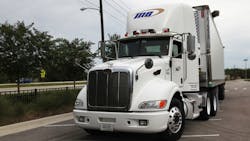COMPANY: The Martin-Brower Co. LLC,
Rosemont, IL
OPERATION: Global supply-chain management and distribution provider for quick-serve restaurant operations
Problem: When you service restaurants, there is a sense of urgency when making deliveries. Too soon, and the product may not sell before it goes bad, literally dumping dollars into the dumpster. Too late, and restaurants lose sales as hungry consumers look for a location that has the food they want.
Add in the changing dynamics of modern supply chains and traffic congestion that can easily delay urban deliveries and you have a complicated recipe that dispatchers must wade through. Then factor in changing sales volumes in stores and even regulatory barriers such as hours of service and it’s any wonder that dispatchers don’t throw up their arms in disgust.
That’s the situation The Martin-Brower Co. found itself in several years ago as all these factors were converging. The logistics company had a software solution in place, but Chuck Gans, director of transportation, says Martin Brower was adapting to a changing marketplace to anticipate its customers’ future needs—and it needed more powerful technology to do so.
“Our old solution wasn’t really advancing with the needs of our delivery customers,” he says. “It wasn’t giving us the ability to accommodate multiple delivery schedules. We wanted to empower our drivers and dispatch with timely and relevant information to provide the highest level of service to our customers.”
Solution: After an exhaustive search that included nearly 20 potential vendors, Martin Brower selected finalists. “We narrowed a very big list down to four, and Paragon Software was among those,” Gans says. “We then brought each of the four in and gave them half-a-day to wow us.”
Gans adds that while the other distributors were involved in the vendor search, they all agreed to allow Martin Brower to make a final recommendation. “We were very careful because we need to protect our partners’ supply chains. It’s up to us to fully vet all the vendor claims,” he says.
In the end, it was a combination of the routing software’s capabilities, the overall presentation, and the comfort level with Paragon Software that finalized the sale. “They exhibited the ability to meet our integrated technology needs,” Gans notes. “We were looking more for a long-term partner rather than a vendor, and Paragon met that from the start.”
With 713 tractors, 1,100 trailers, 1,400 drivers, and 19 distribution centers in its U.S. operation, Martin Brower needed a solution that could manage all those assets and still meet customer requirements. The Paragon solution incorporates data such as expected sales volume at stores, off-load rates, delivery schedules, customer locations, average road speeds en route, rush-hour traffic conditions, and hours of service into its routing and scheduling algorithms.
The average customer receives two to three deliveries per week, Gans notes; in many cases, those deliveries are time-sensitive. “When we arrive at that customer’s location, there are a lot of times that a specific product is dwindling.”
Gans points out that Martin Brower is focused on efficiency, customer service and reducing its impact on the environment. It anticipated a 1% reduction in miles driven upon implementing the Paragon solution. While that may not sound like a lot, he says, it represents a significant reduction for a fleet that traveled 69 million mi. in 2012. There have also been significant savings in some areas, such as the Port Allen, LA, distribution facility, Gans notes.
“We had one customer (with 385 restaurants) that went from twice-a-week deliveries to three times a week,” he relates, “but we didn’t increase our miles [substantially]. The Paragon software enabled us to build a new strategic schedule without increasing our miles.”
Gans says the relationship with Paragon continues to evolve as the software firm adjusts its algorithms along with the needs of Martin Brower’s customers. “Paragon has been a good partner, helping us with enhancements like the hours-of-service rules that went into effect in July,” Gans says. “They are very responsive and we couldn’t have picked a better partner.”
